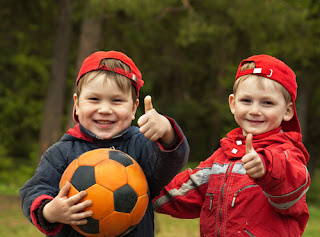Research: "Parents Do Not Understand Child Development in Sports"
For
generations, parents, coaches and teachers have struggled to see sports through
the eyes of a child (Bigelow, Moroney & Hall, 2001). There
are over 40 million children participating youth in sports annually, 12% are under age 6 years (Malina, 2010). The way children develop sports skills has
not changed over time (Cary et
al., 2004). However for generations, adults have been treating
children like miniature adults (Koester, 2000; Twist & Anderson, 2006), and
sadly, the outcomes often end in them dropping out of sports (Malina,
2010). Children as young as elementary-school
aged are quitting reporting their sports experience had little success, a lack
of playing time and an absence of fun (Koester, 2000).
Dr. Paul
Stricker (as cited in Cary et
al., 2004), a pediatric sports medicine specialist, says parents and
coaches do not fully understand child development. He says it is easy for parents to be fooled
by a demonstration of advanced coordination or affinity for sports at an early
age and mistake it as a sign their children possess a unique sports talent(s). “Early
maturers” (Cary, Dotinga and Comarow, 2004, ¶26), as they are called, are often labeled as gifted
at an early age. However, children’s
early talent has been negatively correlated to their reaching elite levels in
sports (Malina, 2010).
In
the Early Years of sports, parents’ and coaches’ encouragement of children
developing their sports skills has been positively correlated to children’s
enjoyment of sports (Conroy,
2006; Hedstrom &
Gould, 2004). A slippery slope is said to be created when
children are asked to mimic professional athletes (Hirschhorn & Loughead, 2000); or are coached using “tradition-bound-resistance”
(Bigelow et al., 2001, p. 119); thinking that discourages the use of age-appropriate equipment (e.g. lower
baskets, lighter baseballs); or when there is a dismissal of the rules designed to
protect children and keep them safe. Bigelow
et al. (2001) write, the slippery slope, or parents’ and coaches’ unreal
expectations, are what put pressure on children (i.e. to throw the ball harder
and faster) and often put them at risk for physical injury.
Albeit exciting for parents to see significant
developments in their children’s growth, Stricker says, “Kids develop sport
skills in a very sequential manner, just like they do sitting up and walking
and talking” (Cary, Dotinga & Comarow, 2004). Yet doctors like Stricker
warn parents that sports development is nothing like potty training. Children should never be made to
repetitiously practice the same movements over and over until they get it. Chronic movements are associated with overuse
injuries from repeated microtrauma to a tendon, muscle or bone and caused by a
specific sport activity—tennis serving, baseball pitching, gymnastic routines,
running, and the shoulder action in swimming (Malina, 2010).
~Coach Pickles


Comments
Post a Comment